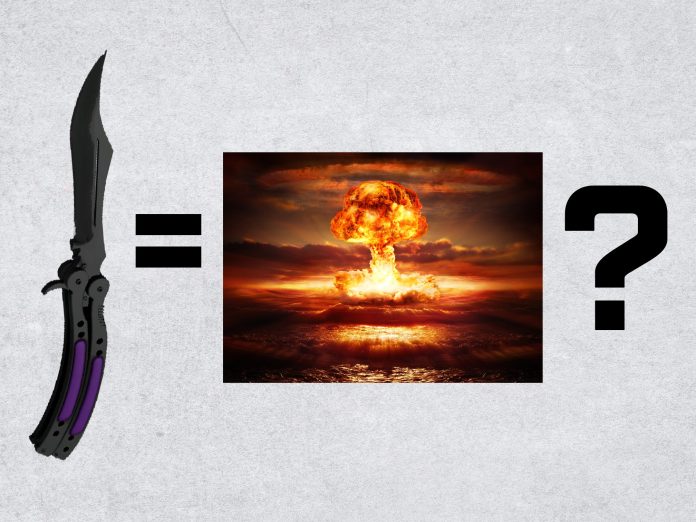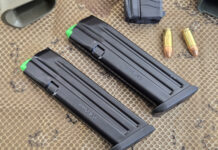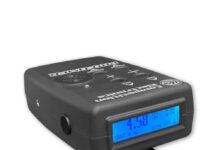
In a case out of Hawaii involving ‘butterfly knives’, a knife that stores the blade in a split handle and can be flipped open, the 9th Circuit is helping to shift the standards for the 2nd Amendment back to their plain text origins. Along with that they are pushing the burden of proof back where it belongs, onto the government, to make the case that an individual does not need a certain armament and not the reverse where a citizen must prove that they do. The presumption emerging is that bearable arms are presumed constitutionally protected until proven otherwise, not that each bearable arm must be proven constitutional to bear.
Duke apparently took this to mean suitcase nukes and I, for one, am tickled by the fear mongering.
From Duke Center for Firearms Law,
In Teter v. Lopez, a Ninth Circuit panel struck down Hawaii’s ban on butterfly knives in an opinion that is hard to understand. The underlying result was presaged in the oral arguments, as this prior post suggests, but the final opinion is still confounding to me. It would not be surprising to see this case go en banc, as has happened with other contested appellation decisions like Range in the Third Circuit and Bondi in the Eleventh Circuit. Such vehement disagreements are a sign of the fissures Bruen has generated in lower courts, especially since this much disagreement so quickly is different than the slower, more cautious approach courts took after Heller and McDonald.
I disagree with the opening sentence. It isn’t hard to understand, you just don’t like it.
Hawaii criminalizes the manufacture, sale, transfer, transport, and possession of butterfly knives, split handle knives in which the sharp edge is covered when the handle is closed.]
Which was silly to do. I can’t really summarize the choice another way, prohibition on possession has never been an effective means of curbing violence. It has only ever modestly shifted methods and never among those who care the least for what is prohibited in the first place. To prohibit something you must have control of its access, and with firearms you don’t They are too simple a machine. Knives and other sharps are even more simpler and much harder to control, we’ve been hand making them for tens of thousands of years.
Now, you can make using a bladed weapon carry a stiff penalty for some added effect, but prohibiting possession is usually an anemic attempt at looking like you are ‘doing something’ to combat violent crime.. blah.. blah.. blah. See the UK banning knives with ‘tips’ for more nonsense.
[ In 2019, two men wanting such knives sued to invalidate the law on Second Amendment grounds. The district court granted summary judgment to the state. Ruling before Bruen, the trial court used the then-controlling two-part framework which first asked whether butterfly knives are within the scope of the Second Amendment and, if it concluded yes, then turned to the second step to apply means-end scrutiny. At the first step, the court asked whether butterfly knives are in “common use” or instead “dangerous and unusual.” It expressly “decline[d] to decide one way or another whether butterfly knives are ‘dangerous and unusual’ weapons not within the scope of the Second Amendment” and instead opted to assume step one was satisfied and move to step two. At step two, the trial court upheld the law under intermediate scrutiny.
So what is almost always a kinda goofy gimmick knife is repaving 2nd Amendment rights and standards. Neat.
Duke, or Jake Charles of Duke, doesn’t seem to think it so neat however.
That is a startling reading of the decisions. It means, for example, that shoulder-fired missiles, suitcase nukes, handheld bio weapons, and many more weapons of mass destruction (so long as they are bearable) are presumptively entitled to Second Amendment protection. A challenger arguing that regulations on such weapons are unconstitutional need do nothing more than file a complaint. The government then bears the burden of proving a tradition of regulating that weapon—an inquiry that, if prior cases are indication, is unpredictable at best.
Yes.
Let me say that again.
Yes. I want that standard in place. Not the reverse where any individual variation of a handgun or an AR-15 has to be reapproved as ‘bearable’ and constitutionally protected in common use. Think that’s a little wild? Did you look at California’s handgun roster rules? How does one prove a firearm is in common use when one has to prove it is before it can be used?
The government should have no issue bringing a case for weapons of mass destruction being removed from the fully bearable constitutionally protected arms list onto a more regulated level, up to prohibition outside of national assets. It isn’t that hard to make the case that WMDs are national strategic assets and useful offensively and defensively in only a ‘we need to erase this city, county, state, etc’ sort of way.
You can scale this argument, and the levels of permissible regulation, all the way down to bearable and strategically useful individual firearms which would have the greatest constitutional protections and basically be untouchable by any manner of prohibitive legislation. There exists an intelligent way to do this.
This again goes against what Duke’s author here feels should be correct and I disagree.
It is also worth emphasizing that the level of generality at which the court found protection for butterfly knives is in a class of arms it designated “bladed weapons.” It didn’t look to see whether this specific type of knife, or any of its progenitors, was protected, but simply grouped it with a broad range of weapons and said it was protected. That high level of generality in looking to antecedents for protection contrasts starkly with the very specific level of generality the court used when looking for regulatory tradition.
Keith’s Theory of Regulation and Authority
The 2nd Amendment is strongly in favor of the armaments most useful to an individual for the protection of themselves and their community. With that in mind we can recategorize a lot of the current legal nonsense into definable groups based on the required user base and strategic value/intent of the arms, even if portable and therefore ‘bearable’ but strategically unsound for an individual. I will even use the NFA’s ‘Title’ system to cover various categories and what the government should be made to argue are their suitability and/or limits to the public.
I will sketch out a reasonable, in my opinion, legal framework of access and general penalties for misuse.
The NFA is out. No such law so blatantly lying about the suitability of a short AR only for crime and unsuitable for regular use over something like barrel length or overall length should be allowed to stand. The government’s own law enforcement data proves unequivocally that the most prominent firearm in criminal use or associated with criminal use is the common and mundane small handgun or small revolver.
Title I – Individual Small Arms
All handguns, shotguns, and rifles will fall into this category up to the .50 BMG. This is will include select-fire rifles and PCC/SMGs and not have barrel length or overall length restrictions. Suppressors will also be Title I items suitable for general and largely unhindered sale. Less lethal and signal munitions for items like 37mm and 40mm launchers are also Title I.
Title I – Regulations Overview
All adult citizens and permanent/long term residents in good standing and under no incomplete adjudication for a serious crime, or adjudication for mental incapability to act safely and in accordance with the law, can purchase a Title I firearm.
Use of a Title I device in furtherance of the commission of a crime carries an increased penalty. Misuse or careless handling of a Title I resulting in property damage or unintentional injury can carry an increased financial penalty for recompense but not disproportionate to the damage inflicted.
Title I items will have no governed database of ownership. Manufacturers tracking inventory for serviceability by serial number is encouraged.
Title II – Crew Served Automatics, Low Yield Explosives & Incendiaries, Small Direct Fire Cannon, Armed Vehicles Capable of Mounting Title I & II Arms
In a departure from one of the current realities, belt-fed and magazine fed autos being the same, I am placing all belt-fed automatics/selecti-fires into Title II and theorizing a higher regulatory status than Title I. Incendiary munitions and small fragmentary explosive munitions would fall into this category. Armored vehicles capable of mounting crew served weapons, light direct fire cannon like the 20mm Lahti, and Armor Penetrating Incendiary or Armor Penetrating Explosive ammunitions could also be categorized here.
Title II – Regulations Overview
Ownership requirements mirror those of Title I items. Ownership can be tracked and kept up to date by state and federal government. This is to rapidly facilitate heavy weapons organization in event of a community need.
[Example, border town or county gets in very hot against a cartel. The sheriff and/or National Guard assets knowing where they can look up and find/request more automatics or anti-material heavier weapons locally has demonstrable value. A legal framework of compulsory lease or service call up can be arranged where the system and owner, if capable, or just the system can be brought into service for community defense. The compelling agency is responsible for costs and replacement as necessary.]
Government can mandate and maintain guidance on the safe use and location for use of fragmentary explosive devices, incendiaries, and direct fire cannon. Failure to adhere to the safe use can result in appropriate financial and criminal penalties for negligence or recklessness.
Simple possession of Title I or Title II devices will not be deemed criminal.
Misuse in furtherance of a crime or intended criminal misuse of Title II devices will be steeply penalized, terrorism charges probable depending upon the circumstance of the offense or intended offense.
Title III – High Explosives, Indirect Fire Weapons, Vehicles with Integrated Cannon, Direct Rocket Systems.
Artillery, Tanks, and other big things that go boom at the impact site. I don’t believe any of these items should be prohibited from private ownership necessarily by there mere existence but with significant system capabilities caveats and safe use, certifications.
Licenses and training for ownership of live fire capable models can be argued for and likely constitutionally sustained, most of these systems require a crew trained to operate them safely. Significant restrictions and zoning on recreationally or educationally firing these systems would be required.
Title IV – Strategic Weapons, Smart Weapons, Guided Weapons, WMDs
Name a large and very expensive weapon system from a HIMARS, to an armed fighter jet, to a missile cruiser or strategic bomber, to yes a suitcase nuke. These are Title IV and will largely be argued to be prohibited from private ownership with possible exceptions case-by-case.
Summary of Titles
I – Unrestricted law abiding adult purchase. Penalties for use in a criminal act. This would cover nearly every firearm in the US with the exception of current NFA belt-feds. Item Examples: any rifle, shotgun, handgun, submachine gun, or select-fire rifle, select-fire shotgun, and less lethal grenades smoke, flash, bean-bag, chalk/trainer.
II – Reported ownership without prohibition of law abiding adult purchase. Increased penalties for use in a criminal act. Regulation and zoning on safe use. Item Examples: belt-fed machine gun, live fragmentary grenades and ammunition, incendiary grenades and ammunition, direct fire (line of sight) cannon and rockets, armored vehicles with mounts for Title I or Title II items.
III – Semi-restricted ownership with training, licensure, and possible insurance requirements to operate. Severe penalties for criminal misuse or negligence. Item Examples: Indirect fire mortars & artillery that fire beyond line of sight, armored vehicles with integrated functional weapons direct or indirect fire.
IV – Prohibited ownership with case by case exceptions for certain systems. Item Examples: a privately owned fighter jet with active systems so pilots can train with or against it, partially decommissioned naval vessel with defense systems still operational and certified but non-DoD crew.
It isn’t detailed. It isn’t perfect. But it makes some semblance of sense, unlike telling me putting a stock kit on a handgun turns into into a Turbo-Crime 9000 (unless you pay $200 and wait a really long time for your permission slip of course).



